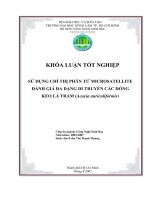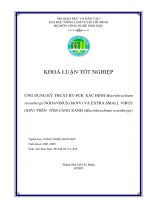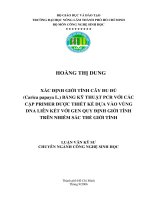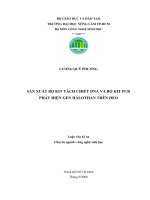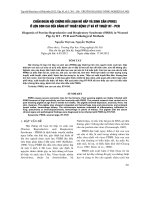Understanding PCR
Bạn đang xem bản rút gọn của tài liệu. Xem và tải ngay bản đầy đủ của tài liệu tại đây (309.23 KB, 14 trang )
Understanding PCR
This Chapter is designed to provide you with essential information to
understand what is happening in the PCR tube. We will consider the
kinetics of the PCR process during the various stages of the reaction and
then outline a basic protocol as a starting point for many PCR experiments.
2.1 How does PCR work?
PCR proceeds in three distinct steps governed by temperature.
● Denaturation: the double-stranded template DNA is denatured by heat-
ing, typically to 94°C, to separate the complementary single strands.
● Annealing: the reaction is rapidly cooled to an annealing temperature to
allow the oligonucleotide primers to hybridize to the template. The
single strands of the template are too long and complex to be able to
reanneal during this rapid cooling phase. During this annealing step the
thermostable DNA polymerase will be active to some extent and will
begin to extend the primers as soon as they anneal to the template. This
can lead to specificity problems if the annealing temperature is too low
(Chapter 4).
● DNA synthesis: the reaction is heated to a temperature, typically 72°C
for efficient DNA synthesis by the thermostable DNA polymerase.
In the first cycle of PCR each template strand gives rise to a new duplex, as
shown in Figure 2.1(A), doubling the number of copies of the target region.
Likewise at each subsequent cycle of denaturation, annealing and
extension, there is a theoretical doubling of the number of copies of the
target DNA. If PCR achieved 100% efficiency then 20 cycles would yield a
one million-fold amplification of the target DNA (2
20
= 1 048 572). Of course
PCR is not 100% efficient for a variety of reasons that we will consider
shortly, but by increasing the number of cycles and optimizing conditions
amplification by 10
6
-fold or greater is routinely achievable.
One of the great advantages of PCR is its ability to amplify a defined
region of DNA from a very complex starting template such as genomic
DNA. It is therefore worth dissecting what is happening during PCR ampli-
fication from a genomic DNA template as this will provide a better
understanding of the reaction process (Section 2.3).
PCR uses two oligonucleotide primers that act as sites for initiation of
DNA synthesis by the DNA polymerase and so these primers define the
region of the template DNA that will be copied (1). DNA polymerases need
a primer to begin DNA synthesis and so we need to know at least small
parts of the DNA sequence of the target region in order to be able to design
these primers. The primers (sometimes called amplimers) are comple-
mentary to regions of known sequence on opposite strands of the template
DNA and their 3′-OH end points towards the other primer. The primer is
2
10 PCR
(A) The first cycle of a PCR reaction
Double-strand
template
Denaturation
of template
Annealing
of primers
DNA synthesis
Products of
first PCR cycle
Primers
Template
Key
72°C
55°C
95°C
(C) The third cycle of a PCR reaction
Products of
second PCR cycle
Denaturation
of template
Amplification of
defined-length
product
72°C
55°C
95°C
Annealing
of primers
DNA synthesis
1
2
3
4
5
6
7
8
1
2
3
4
5
6
7
8
(B) The second cycle of a PCR reaction
95°C
55°C
72°C
Products of
first PCR cycle
Denaturation
of template
Annealing
of primers
DNA synthesis
Appearance of
defined length
product
(D) The fourth cycle of a PCR reaction
Products of
third PCR cycle
Exponential
amplification of
defined-length
product
1
2
3
4
5
6
7
8
×3
×3
extended by the DNA polymerase incorporating the four deoxynucleotides
(dATP, dGTP, dCTP and dTTP) in a template-directed manner. The DNA
sequence between the two primer binding sites will therefore be replicated
during each cycle of the PCR. The reaction vessel, a 0.2 ml or 0.5 ml
polypropylene microcentrifuge tube or well of a microtiter plate, is placed
in a thermal cycler and subjected to a series of heating and cooling reactions
as outlined in Figure 2.2.
A typical PCR protocol is provided at the end of this Chapter in Protocol
2.1 and so you should refer to this as issues are highlighted in the remainder
of this Chapter.
At the start of a PCR there is usually an extended denaturation step at
94°C for 2–5 min to ensure that the template DNA is efficiently denatured.
There are then usually three temperature-controlled steps:
● 94°C to denature the template strands; then
● 40–72°C (55°C is often used as a good starting point) to allow the primers
to anneal; then
● 72°C, the optimal temperature for many thermostable DNA polymerases
to allow efficient DNA synthesis (2).
These three steps are repeated usually for between 25 and 40 times, as
necessary, for the specific application. Normally there is then an extended
72°C step to ensure that all of the products are full-length. Finally the
reaction is cooled to either room temperature or 4°C depending upon the
application and type of thermal cycler used.
2.2 PCR: a molecular perspective
A good way to understand any molecular biology process is to think about
what is going on at the molecular level. Try to imagine what is happening
to the different types of molecules in a reaction tube. Ask yourself questions
about the reactants and what will happen to these as the reaction proceeds.
● What are the relative concentrations of the various reactants?
● Which reactants are present in excess and which are limiting?
● What interactions are going on between molecules such as enzymes and
DNA?
● What factors will influence these molecular interactions?
● What are the activities of the enzyme and how will these modify the
DNA?
● What are the products of the reaction and how will their accumulation
affect the reaction?
Understanding PCR 11
Figure 2.1 (opposite)
PCR theoretically doubles the amount of target DNA at each cycle. (A) Cycle 1,
products generated from template DNA are not of a defined length. (B) Cycle 2,
the first single-strand products of defined length are produced due to priming on
single-strand products generated during cycle 1. (C) Cycle 3 results in the
production of the first double-strand products of defined length. (D) Cycle 4 and
subsequent cycles lead to exponential amplification of the defined length
products. In parts C and D the various strands are numbered to enable the
templates and products to be followed.
It is sometimes useful to think about a single enzyme molecule in the
reaction tube and to consider how it works to gain a molecular perspective
on the reaction.
A genomic DNA template
PCRs are usually performed on template DNA molecules that are longer
than the target region that we wish to amplify. The extreme case is where
we start with genomic DNA. A key question is ‘How does the DNA
polymerase know when it has reached the end of the target region that is
to be copied?’ The answer is that it does not know; it therefore carries on
synthesizing new DNA until the temperature of the reaction is increased
during the denaturing step of the next PCR cycle (see Figure 2.1(A)). If we
think about a simple case where we start with one molecule of genomic
DNA, then, after one cycle of PCR we will have the original template strands
and two new strands, initiated from the primers. These new strands will be
much shorter than the original genomic strands, but will still be longer
than the target region to be amplified. Importantly however, one end of
each of the new strands now corresponds to a primer sequence. In the
second cycle, the primers again anneal to the original templates but also
to the strands synthesized during the first cycle. The DNA polymerase will
extend from the primers, and again the original templates will give rise to
longer strands of undefined length. However, on the strands synthesized
during the first cycle the enzyme will ‘run out’ of template DNA when it
reaches the end of the primer sequence incorporated during the first cycle.
So, by the end of this second cycle we have produced two single strands of
12 PCR
94
72
55
20
Initial
denaturation Cycle 1 Cycle 2 Cycle 3
DD
AA
S
etc.
Time
Temperature (°C)
S
Figure 2.2
Representation of thermal cycling during a PCR. The reaction is heated from room
temperature to an initial denaturation phase of around 5 min at 94°C to ensure
the original template strands are now single-stranded. There then follows a series
of repeated cycling steps through temperatures for denaturation of double-
stranded molecules (D), annealing of primers to template (A) and DNA synthesis
from the primer (S).
DNA that correspond to the product length defined by the two primers
(Figure 2.1(B)). These defined-length strands are now amplified in each
subsequent cycle leading to an exponential accumulation of this target PCR
product. This is illustrated in Figure 2.1(C) and (D) and Table 2.1.
This exponential amplification of the target PCR product contrasts
dramatically with the linear accumulation of the longer strands copied from
the original template molecule. Every PCR cycle produces only two further
elongated DNA strands for each original template DNA molecule. As you
can also see from Table 2.1 by the end of 20 cycles in an ‘ideal PCR’, for
every original template molecule there will only be 42 single strands of DNA
of undefined length, including the two original template strands. So the
theoretical 10
6
double-strand product molecules of correct length generated
for each original template duplex are present in vast excess over these
strands of undefined length.
As illustrated in Table 2.1, amplification at 100% efficiency should
generate some 10
6
product molecules per original template molecule. So,
under these ideal conditions starting with 1 µg of human genomic DNA
(around 3 × 10
5
molecules) a single copy target sequence should theoretic-
ally be amplified to yield 3 × 10
11
product fragments after 20 cycles. In
practice, as with most biological reactions, PCR amplification is not 100%
efficient, so normally a greater number of cycles (25–40) are performed to
achieve these levels of amplification.
Understanding PCR 13
Table 2.1
Theoretical accumulation of PCR products during the first 20
cycles of a PCR with a single genomic DNA template
Number of Number of Number of
Cycle single strands of single strands of copies of
number undefined length defined length double-strand target
02 0 1
a
14 0 2
26 2 4
38 8 8
410 22 16
512 52 32
6 14 114 64
7 16 240 128
8 18 494 256
9 20 1 004 512
10 22 2 026 1 024
11 24 4 072 2 048
12 26 8 164 4 096
13 28 16 356 8 192
14 30 32 738 16 384
15 32 65 504 32 768
16 34 131 038 65 536
17 36 262 108 131 072
18 38 524 250 262 144
19 40 1 048 536 524 288
20 42 2 097 110 1 048 576
a
This copy represents the original target DNA which therefore represents two single strands
of undefined length.

